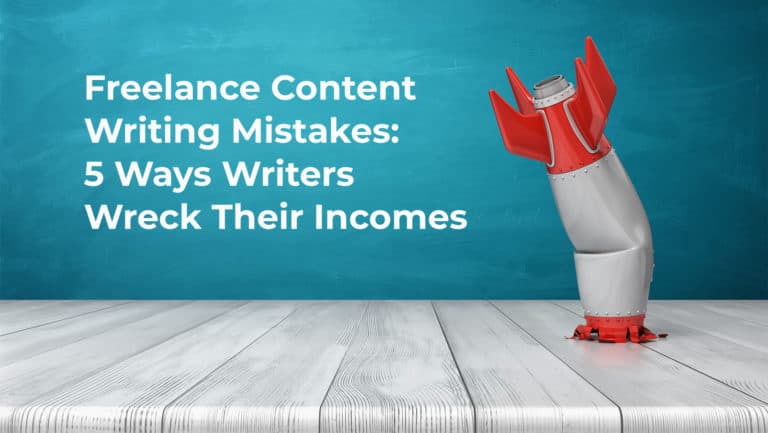Key Takeaways of the Freelance Writers Survey [VIDEO]
This video summarizes the key findings of a survey of 1,300 freelance writers. If you want to improve your freelance writing business, it’s definitely worth watching.
I’ve also got a blog post that reviews the results of this survey.
TRANSCRIPT
So what really makes a difference in whether a freelance writer earns a living wage or not? That’s what we’re going to cover in this video.
So about two years ago, I did this really big survey of freelance writers. I asked over thirteen hundred freelance writers about 35 different questions about how they earn their living, how much they earn, where they get clients, how they work, etc.
I was able to break out the results into low earners, medium earners and high earners. As you can see in this pie chart, it broke out fairly neatly with:
- 28 percent of freelance writers earning less than $15 per hour
- 28 percent are earning more than $45 per hour
- 44 percent earning between $15 and $45 per hour
This video is going to cover the differences between those two groups and what the high earners are doing that the lower earners aren’t.
The painful thing I learned in this survey is that most freelance writers, 57 percent, are earning $30 per hour or less. That’s okay compared to many other jobs, but once you pull out 35 percent of every dollar that you earn for taxes and overhead, that $30 per hour starts to get a lot smaller.
The other thing that was actually even more of a concern was that only 11.4 percent of freelance writers were earning $75 per hour or more.
If you’ve ever worked with a freelance writing coach, they’ll tell you that $75 per hour is kind of considered to be a bright line for a professional income for a freelancer. Part of this is because, as I mentioned, 35 percent of every dollar you make is lopped off for taxes and overhead. But freelance writers also have to do things like pay for health insurance, which can be anywhere from $400 to $900 or more per month.
$75 also, if you happen to have children, can be just enough to get from A to B. If you live in a large city, $75 per hour is really required.
So you can certainly can earn a living if you’re bringing in less than $75 per hour. But it is the recommended target for freelance writers and freelancers in general.
So let’s look exactly at what makes a difference between who’s earning a living and who’s not.
Freelance writers who have been doing it for 10 years or more are dramatically more likely to be earning $45 per hour than their under-earning peers.
This was a really a startling takeaway of this survey because it really happens right at 10 years. 10 years is a long time to struggle through. I wouldn’t want you to have to spend any longer in the $15 per hour category than you’d have to.
One of the best ways to get out of that $15 per hour category is to get away from the content mills and to get over to working directly with clients, particularly if you work directly with companies who have 51 employees or more.
These people are a little bit harder to approach… actually they’re not harder to approach, they’re just a little bit more intimidating to approach than, say, a content mill. But look at the difference between the low earners versus the high earners. High earners are like six times more likely to be working with this type of company rather than the under earners who unfortunately are about five times more likely to be working with content mills.
Here’s another really important thing to know about how people are finding their work. This is always a perennial issue with freelance writers is how are you getting work? And so these are honestly the two biggest ways that people get work. Clearly, it’s through their network and client referrals.
So while all these other tactics are good and you might want to have them in your wheelhouse, if you only focus on your personal network and your client referrals, you could probably get from A to B as a freelance writer and be at the $45 per hour earning level or higher just by focusing on these two things.
So if you happen to be having trouble finding work right now, ask yourself, how’s your network? What have you been doing to expand and beef up your network recently? Have you been asking for client referrals? How have you been asking for client referrals? Have you been asking for them more than once? Do you offer a monetary incentive for a client referral?
All of these things are really important and can make a difference whether you’re in the $15 per hour group or the $45 per hour group.
This one is one of my most important takeaways from this survey, and it lined up the most with my own personal experience. As you can see from this chart, people who work with B2B companies, as in business to business companies, are much more likely to earn $45 per hour or more.
It was also interesting in this survey and a different question I asked people basically “the happiness question.” I asked them, “would you recommend freelance writing to a friend?”
The choices to answer with were:
- “Absolutely, yes. It’s a great way to earn a living.”
- “I would recommend it, but it’s hard and it’s not for everyone.”
- Kind of a neutral option of like “I could go either way.”
- “I wouldn’t recommend it. It’s a little bit too hard and not rewarding enough.”
- “It’s a terrible way to make a living and I wouldn’t recommend it to anybody.
The people who answered more on the positive side were dramatically more likely to be B2B writers. It was really interesting to see the data break out that way.
The B2C writers weren’t universally unhappy, but they were much more likely to say that they would not recommend freelance writing to a friend then the B2B writers.
So here’s another really critical thing about whether people earn a living or not. It’s the type of writing they do. As you can see, all the classic recommendations are here. White papers, case studies, landing pages, press releases, even. These are great ways to earn a high hourly rate. But I am still very fond of the long-form blog post because it’s recurring work. I’ve found in my freelance writing business, the more recurring work I get, the more money I earn per hour and also per month and per annum.
This really popped out in the data because when I did ask people how much recurring work do you get approximately,” the people who said most of their freelance writing work is recurring, they’re twice as likely to earn $45 per hour or more. The people who get no recurring work or very little recurring work are dramatically more likely to be in the group of people earning $15 per hour or less.
I mentioned that one’s personal network and client referrals are the best ways to get clients. This chart really lines up with that idea about the personal network because as you can see, freelance writers who have a significant but not a massive following on social media are much more likely to earn $45 per hour.
I think this all comes down to being visible and having a social media platform is definitely one of the better ways to be visible these days.
Finally, here’s what ended up not making as much of a difference as I thought it was going to.
As you know, we all get recommendations as freelance writers. “You’ve got to have a web site. You’ve got to have a web site.” I absolutely want all freelance writers to have a web site. But here’s the reality: among the high earners, yes, 77 percent of them had a web site. But among the low earners, 64 percent of them had a web site.
This is not like an earthquake’s difference in data. The high earners are a little bit more likely to have their own site, but having a web site alone is no guarantee you’re going to earn a good hourly wage as a freelance writer.
So I hope that was all helpful and it gives you a lot of insights on how you might want to manage your freelance writing business going forward.

